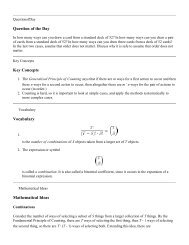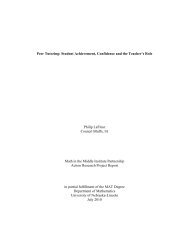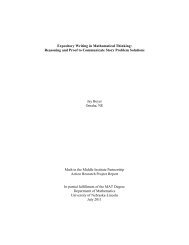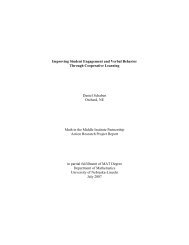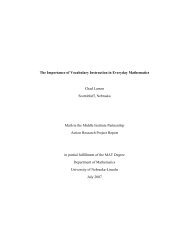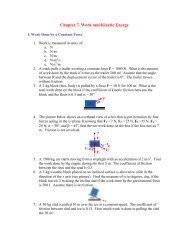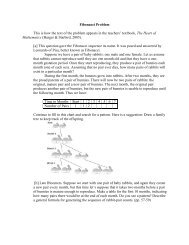The Simple Complexity of Pascal's Triangle
The Simple Complexity of Pascal's Triangle
The Simple Complexity of Pascal's Triangle
- No tags were found...
You also want an ePaper? Increase the reach of your titles
YUMPU automatically turns print PDFs into web optimized ePapers that Google loves.
<strong>The</strong> <strong>Simple</strong> <strong>Complexity</strong> <strong>of</strong> Pascal’s <strong>Triangle</strong>By Susan LeavittIn partial fulfillment <strong>of</strong> the requirements for the Masters <strong>of</strong> Arts in Teaching with aSpecialization in the Teaching <strong>of</strong> Middle Level Mathematics in the Department <strong>of</strong> Mathematics.Dr. Jim Lewis, AdvisorJuly 2011
Leavitt – MAT Expository Paper - 2<strong>The</strong> <strong>Simple</strong> <strong>Complexity</strong> <strong>of</strong> Pascal’s <strong>Triangle</strong>Pascal’s triangle is one <strong>of</strong> the most famous and interesting patterns in mathematics. Infact, while studying this triangle that initially appears to consist <strong>of</strong> a simple pattern <strong>of</strong> numbers,one learns that it contains many complex patterns. This paper briefly looks at the history <strong>of</strong>Pascal’s triangle and how it is defined and then explores not only its connection with algebra andprobability, but also some <strong>of</strong> the intriguing patterns and topics contained within Pascal’s triangle.History<strong>The</strong> history <strong>of</strong> Pascal’s triangle begins at least 500 years before its name sake, BlaisePascal, was even born. In the 10 th and 11 th centuries, Indian and Persian Mathematicians firststarted working on this pattern <strong>of</strong> numbers. Also during the 10 th century various Arabmathematicians developed a mathematical series for calculating the coeffients for (1 + x) n whenn is a positive number. In addition, around 1070 Omar Khayyam, a Persian Mathematician,astronomer and philosopher worked on the binomial expansion and the numerical coefficients,which are the values <strong>of</strong> a row in Pascal’s triangle.In China in the 13 th century, hundreds <strong>of</strong> years before Pascal, Yang Hui worked on theexact same pattern as we know it today. Consequently, the Chinese will not refer the pattern asPascal’s triangle, and even to date it is known as Yang Hui’s <strong>Triangle</strong> in China.It wasn’t until around 1654, that the French mathematician and philosopher, BlaisePascal, began to investigate the triangle. His discussions with Peirre de Fermat on the chance <strong>of</strong>getting different values for rolls <strong>of</strong> dice led him to the triangle. <strong>The</strong>se discussions later laid thefoundation for the theory <strong>of</strong> probability. <strong>The</strong> two major areas where Pascal’s triangle is usedtoday are in algebra and probability specifically in regards to combinatorics. Pascal is creditedbecause he investigated and took the information on this system <strong>of</strong> numbers, compiled andorganized it so it made sense and was more useful. Pascal died in 1662 at the age <strong>of</strong> 39 before his
Leavitt – MAT Expository Paper - 3work was published. In 1665, his work Traite du triangle arithmetique was published. In theearly 1700s, two mathematicians, Pierre Raymond de Montmort and Abraham de Moivre,published articles each naming the triangle after Pascal and so it became known as Pascal’sArithmetic <strong>Triangle</strong>.Symbolically DefinedBlaise Pascal’s work titled Traite du triangle arithmetique when translated into Englishmeans, A Treatise on the Arithmetical <strong>Triangle</strong>. In the first part <strong>of</strong> this publication, he definesthe triangle as an unbounded rectangular array. Below in Figure 1, is an example <strong>of</strong> Pascal’srectangular array and below that to the right is the array rotated 30 degrees to show the morefamiliar triangular appearance.Figure 1Using the rectangular matrix Pascal defined the triangle symbolically using {f i,j } where:
Leavitt – MAT Expository Paper - 4f i,j = f i,j-1 + f i-1,j i, j = 2, 3, 4 . . .f i,1 = f 1, j = 1 i, j = 1, 2, 3 . . .{f i,j }is the entry that occurs in th i th row and the j th column. See the matrix in Figure 2 below.First <strong>of</strong> all, the equation: f i,1 = f 1, j = 1i, j = 1, 2, 3 . . . is used to represent what isreferred to as the special case where each cell in the first row and column <strong>of</strong> the matrix containthe number 1. <strong>The</strong>diagram <strong>of</strong> the arrayshows the first part <strong>of</strong>this equation f i,1 = 1,where the indexnumber for i can beany value starting withthe initial value <strong>of</strong> 1and j is always equalto 1. This results in theFigure 2cells <strong>of</strong> the first column always containing the value <strong>of</strong> 1. <strong>The</strong> index i can be any number that isone or greater so the row placement will vary while the index j will always be 1 so the columnwill remain the same.Conversely, the diagram shows the second part <strong>of</strong> this equation f 1, j = 1, where the indexnumber for i is always equal to 1 and the index for j can be any value starting with the initialvalue <strong>of</strong> 1. This means the cells <strong>of</strong> the first row will always contain the value <strong>of</strong> 1.
Leavitt – MAT Expository Paper - 5And finally, the equation f i,j = f i,j-1 + f i-1,ji, j = 2, 3, 4 . . applies for all cells with indexvalues above f 2,2 or in other words all the other cells <strong>of</strong> the array other than what is referred toabove as the special case where all the cells <strong>of</strong> the first row and column each contain the value <strong>of</strong>1. In the equation f i,j = f i,j-1 + f i-1,j the first term f i,j-1 refers to the current row and the previouscolumn while f i-1,j refers to the previous row and current column. In matrix in Figure 2, note thatf 4,6 = 56 because f 4,5 + f 3,6 = 35 + 21 and more generally f i,j = f i,j-1 + f i-1,j , for any entry whereboth i and j are greater than 1, the entry is the sum <strong>of</strong> the entry to the left plus the entry above the“i,j” entry.Most people today are more familiarwith Pascal’s triangle shown in triangular formas in Figure 3. For each row <strong>of</strong> Pascal’s<strong>Triangle</strong>, the first and last entry is a 1. For allother entries, each term is the sum <strong>of</strong> the twonumbers that are in the row above it to theFigure 3immediate left and right. However, you can think <strong>of</strong> the triangle as being surrounded by zeros. <strong>The</strong>nPascal’s description <strong>of</strong> adding the previous cell in the same row and the previous cell in the samecolumn becomesadding the twoRow 2Row 3numbers above the cellto the right and leftwhich is illustrated inFigure 4Figure 4.<strong>The</strong>re are a couple <strong>of</strong> other points to keep in mind when working with Pascal’s triangle. First<strong>of</strong> all when numbering the rows, the top row is counted as row zero and then the next is row one and
Leavitt – MAT Expository Paper - 6so on. <strong>The</strong>n when counting the position <strong>of</strong> the numbers within each row, start from the left and thefirst number is in position zero, then position 1 and so on. <strong>The</strong> counting <strong>of</strong> rows and position withinthe row is shown in Figure 5.Figure 5And finally, an entry in Pascal’s triangle can also be reference using the C(n, r) format forcombinations. This is read n Choose r, where n in the row number and r is the entry within the row.For example: C(3,0) refers to row 3 and position 0 within that row. This concept will be exploredmore thoroughly in another section <strong>of</strong> this paper, but for now the format for combinations also can bewritten in the following way:⎛n ⎞⎜ ⎟ . <strong>The</strong>n Pascal’s triangle can also be written in terms <strong>of</strong> its⎝r⎠combinatorial equivalents as shown inFigure 6. Now that we know how thenumbers are arranged in row andcolumn within the triangle, let’s look atsome relationships that exist between thenumbers contained within Pascal’striangle.Figure 6
Leavitt – MAT Expository Paper - 7Sum <strong>of</strong> Each Row<strong>The</strong> sum <strong>of</strong> the numbers in any row in Pascal’s triangle is equal to 2 to the power <strong>of</strong> thenumber <strong>of</strong> the row or 2 n where n is the number <strong>of</strong> the row. (Recall that the first row is Row 0.)Figure 7 below illustrates the first 5 rows <strong>of</strong> Pascal’s triangle and the corresponding sum <strong>of</strong> each rowand their equivalent powers <strong>of</strong> 2.Sum <strong>of</strong> the Rows Pascal’s <strong>Triangle</strong> Row # 2 n1 Row 0 2 0 = 11 + 1 = 2 Row 1 2 1 = 21 + 2 + 1 = 4 Row 2 2 2 = 41 + 3 + 3 + 1 = 8 Row 3 2 3 = 81 + 4 + 6 + 4 + 1 = 16 Row 4 2 4 = 16Figure 7One can use Figure 4 to gain insight into why each row (after the 0 th row) is twice theprevious row. Note that since each entry <strong>of</strong> Row 2 is an addend <strong>of</strong> two entries on Row 3, the sum <strong>of</strong>the entries on Row 3 is twice the sum <strong>of</strong> the entries on Row 2.We use induction to establish this fact more generally. C(n,r) was previously defined to bethe r th term on the n th row <strong>of</strong> Pascal’s <strong>Triangle</strong>. We know C(n,0) = 1=C(n, n) for all n = 1, 2, 3, . . .This represents the special case row and column, where for example if n= 3 then C(3,0) = 1 andC(3,3) = 1We also know C(n, r) = C(n – 1, r -1) + C(n -1, r) for 1 ≤ r ≤ n-1. An example <strong>of</strong> this wouldbe to let n = 3 and r = 2 which makes the following statement: C(3, 2) = C(2, 1) + C(2, 2) also true.Our induction assumption is that for n > 0, we haveC(n-1,0) + C(n-1,1) + C(n-1, 2) + . . . + C(n-1, n-1) = 2 n-1 .
Leavitt – MAT Expository Paper - 8<strong>The</strong>n let’s assume thatCn−1n− 1,0+ Cn−1,1+ Cn−1,2+ ... + Cn−1, n−1= 2for n > 1 which leads us toCn,0+ C= (0 + C= 2n−1n,1n−1,0+ 2+ Cn−1n,2+ C= 2n−1,1n+ ... + C+ Cn,nn−1,2= (0 + C+ ... + Cn−1,0n−1,n−1) + ( C) + ( Cn−1,0n−1,0+ C+ Cn−1,1n−1,1) + ( C+ Cn−1,1n−1,2+ Cn−1,2+ ... + C) + ... + ( Cn−1,n−1+ 0)n−1,n−1+ 0)This proves that what was found in the table in Figure 7 to be true is true in general, so thesum <strong>of</strong> the numbers in any row in Pascal’s triangle is equal to 2 n where n is the number <strong>of</strong> the row.How Pascal’s <strong>Triangle</strong> Relates to Combinations and Binomials<strong>The</strong> study <strong>of</strong> combinatorics is a branch <strong>of</strong> mathematics that studies finite or discretestructures and includes permutations and combinations. If we start with a set <strong>of</strong> n objects and askhow many ways can we select a subset <strong>of</strong> r objects, we are asking how many combinations arepossible. Note that the order in which the objects are selected does not matter. Take for example,making a fruit salad in which there are 5 fruits to choose from that include: strawberries, oranges,blackberries, apples, and grapes and you can choose to use or not use each fruit in your salad.(We are not discussing how much <strong>of</strong> each fruit is used.)Let:S = strawberriesO = orangesB = blackberriesA = applesG = grapes1. When choosing zero fruit for the salad there is only one combinationNo combination → 1 selection2. If you choose only one fruit for the salad, since there are five fruits, there are fivedifferent ways to make a salad.S, O, B, A, G → 5 selections3. In choosing two different kinds <strong>of</strong> fruits the list <strong>of</strong> combinations for the fruit saladwill look like:SO, SB, SA, SG, OB, OA, OG, BA, BG, AG → 10 selections
Leavitt – MAT Expository Paper - 94. In choosing three different fruits the list <strong>of</strong> combinations will look like:SOB, SOA, SOG, SBA, SBG, SAG, OBA, OBG, BAG, OAG → 10 selections5. In choosing four different kinds <strong>of</strong> fruits the list <strong>of</strong> combinations will look like:SOBA, SOBG, OBGA, SBAG, SOAG → 5 selections6. And finally, when choosing all five fruits for the salad there is only one combination.SOBAG → 1 selectionListing all the possible combinations is tedious and it becomes very easy to make a mistakeand miss options. Thus, it is almost impossible for larger combinations. Note that when choosingmore than one different type <strong>of</strong> fruit for the salad, the order in which the fruit is chosen doesn’tmatter. For instance adding blackberries and then the apples is the same as adding the apples andthen the blackberries. Thus, this is a combination instead <strong>of</strong> a permutation.At this point, we want to establish a general fact behind what we see to be true for thisexample. We claim C(n,r) is the number <strong>of</strong> r-element subsets <strong>of</strong> a set <strong>of</strong> S that contains nelements for any r, 0 ≤ r ≤ n. We prove this by induction on n.If S = { } then S has 1 subset that contains no elements. And if S = {x} then S has 1subset that contains no elements. This corresponds to C(1,0) = 1. S also has 1 subset thatcontains 1 element which corresponds to the fact that C(1,1) = 1.We assume that for n > 1, C(n-1, r) is the number <strong>of</strong> r element subsets <strong>of</strong> a set with n-1elements and for any r, 0 ≤ r ≤ n-1.Consider C(n,r) and a set S n = {1, 2, 3, … n-1, n}. Organize the r-element subsets <strong>of</strong> S ninto two disjoint sets; A, which is the set <strong>of</strong> subsets <strong>of</strong> S that do contain n, and B, the subsets thatdo not contain n.If we remove n from each <strong>of</strong> the subsets <strong>of</strong> A, we have the collection <strong>of</strong> all subsets <strong>of</strong>[1,2,3,…(n-1)] that contain (r-1) elements. <strong>The</strong>refore, by induction, the size <strong>of</strong> set A isC(n-1, r-1).
Leavitt – MAT Expository Paper - 10Moreover, none <strong>of</strong> the sets in B contain n, so each is also a subset <strong>of</strong> {1, 2, 3 … (n-1)}that contains r elements. Our inductive analysis <strong>of</strong> this shows that the size <strong>of</strong> set B is C(n-1, r).Since C(n,r) = C(n-1, r-1) + C(n-1, r) we have established that the number <strong>of</strong> r elementssubsets <strong>of</strong> a set with n elements is C(n, r). Now we would like to establish the formula,C(n, r) =⎛n ⎞⎜ ⎟ , where⎝r⎠⎛n⎞n!⎜ ⎟ is defined as⎝r⎠r!(n −1)!.This too is an induction pro<strong>of</strong> on n, with the Case n = 0 (C(0, 0) = 1 =0 ! ) being obvious.0!0!Now assume that if n > 0, then for all r, 0 ≤ r ≤ n-1 we have C(n-1, r) =n!.r!(n −1)!Note first that C(n,0) = 1 =n!0!( n − 0)!⎛n⎞= ⎜ ⎟ which is the left end <strong>of</strong> the nth row <strong>of</strong> Pascal’s⎝0⎠triangle. And C(n,n) = 1 =n!n!(n − n)!⎛n⎞= ⎜ ⎟⎝n⎠which is the right end <strong>of</strong> the nth row <strong>of</strong>Pascal’s triangle.We consider the situation where 1 ≤ r ≤ n-1 and C(n,r) = C(n-1, r-1) + C(n-1, r)( n −1)!( n −1)!( n −1)!( n −1)!=+=+( r −1)!((n −1)− ( r −1))!r!(n −1−r)!( r −1)!(n − r)!r!(n −1−r)!( n −1)!1 1 ( n −1)!r + n − r n!= [ + ] =[ ] = .( r −1)!(n − r)!n − r r ( r −1)!(n − r)!r(n − r)!r!(n − r)!This general formula is consistent with our example, e.g. C(5,2) = 10 and5!= 10.2!(5 − 2)!So how can Pascal’s triangle be used in combinatorics? Think <strong>of</strong> Pascal’s triangle as a simpleway to do calculations. For example, look at the last column in the table in Figure 8 and compare thatto Row 5 in Pascal’s triangle in Figure 5. Now look at the last two columns in the table together.
Leavitt – MAT Expository Paper - 11<strong>The</strong> third entry is C(5,2) corresponds to the fifth row second position. Thus, if one wants t<strong>of</strong>ind the number <strong>of</strong> two element subsets in a five element set, rather than perform the calculationsrequired, one can simply look at Pascal’s triangle. In the combination format C(n, r) or n choose r,the row number in Pascal’s triangle corresponds to the n or the total number <strong>of</strong> objects to choosefrom and the position within the row in Pascal’s triangle corresponds to the r or the number <strong>of</strong>objects to bechosen. However,it must beremembered thatthe row andposition inFigure 8Pascal’s triangle begins with zero.Pascal states the combinatorial relation in the formula for finding f i,j in the following way:C(n+1, r+1) = C(n, r) + C(n, r+1)Using the example C(6,3) we let n = 5 and r = 2.<strong>The</strong>nC(5 + 1, 2 + 1) = C(5, 2) + C(5, 2 + 1) orC(6,3) = C(5,2) + C(5,3), which is shown in Figure 9.C(5,2)C(5,3)Figure 9C(6,3)
Leavitt – MAT Expository Paper - 12Recall that as early as the 10 th century, various Arab mathematicians developed amathematical series for calculating the coeffients for (1 + x) n when n was a positive number. Aswe will learn, the entries in Pascal’s triangle correspond to the coefficients in a binomial expansion,and thus they are commonly referred to as binomial coeffients.A binomial expression is an expression with two terms such as x + y and binomial expansionrefers to the formula to expand out binomials raised to a certain power. Given the binomialexpression (x + 1) 2 we know that it is equal to (x + 1)(x + 1). When this binomial expression isexpanded (or multiplied through) it is equal to 1x 2 + 2x + 1. On the following page figure 10 whichcontains a table showing the binomial expression (x + 1) raised to the powers <strong>of</strong> zero through 5.Notice that for each expansion, the coefficients correspond to a row in Pascal’s triangle.Figure 10This motivates us to look at the coefficients and their relationship to the Binomial <strong>The</strong>oremwhich states that for any n ≥ 1.⎛n⎞⎝0⎠⎛n⎞⎝1⎠⎛n⎞⎝r⎠⎛n⎞⎝n−1⎠⎛n⎞⎝n⎠nnn−1n−rrn−1n( x + y) = ⎜ ⎟x+ ⎜ ⎟xy + ... + ⎜ ⎟xy + ... + ⎜ ⎟xy+ ⎜ ⎟y⎛1⎞= ⎜ ⎟⎝0⎠⎛1⎞+ ⎜ ⎟⎝1⎠This too is an induction pro<strong>of</strong>. Clearly ( x y) x y+1so the theorem is true for n = 1.Assume n > 1 and the theorem is true for n – 1.nn( ) ( )( ) − 1 n+ = + + = ( + ) −1+ ( +nx y x y x y x x y y x y) −1
Leavitt – MAT Expository Paper - 13⎛⎛n−1⎞⎞n−1⎛n−1⎞n−2⎛n−1⎞n−1= x ⎜⎟⎜ ⎟x+ ⎜ ⎟xy + ... + ⎜ ⎟y+⎝⎝0⎠ ⎝1⎠ ⎝n−1⎠⎠⎛⎛n−1⎞n 1 ⎛n−1⎞n−2⎛n−1⎞n−y ⎜⎜ ⎟x+ ⎜ ⎟xy + ... + ⎜ ⎟y⎝⎝0⎠ ⎝1⎠ ⎝n−1⎠− 1⎞⎟⎠Collecting coefficients, the coefficient <strong>of</strong> x n is⎛n−1⎞⎛n⎞⎜ ⎟ = 1 = ⎜ ⎟⎝n−1⎠⎝n⎠⎛n−1⎞⎛n⎞⎜ ⎟ = 1 = ⎜ ⎟⎝0⎠ ⎝0⎠and the coefficient <strong>of</strong> y n isConsider now a term x n-r y r where 1 ≤ r ≤ n-1, from the first expression we get the term⎛n−1⎞n−1−⎜ ⎟ • x • x⎝r⎠r r• yand from the second we get⎛n−1⎞n − r r −1⎜ ⎟ • y • x • y⎝r−1⎠When we add them we get the coefficient <strong>of</strong> term x n-r y r to be⎛n−1⎞⎛n−1⎞⎜ ⎟ + ⎜ ⎟⎝r⎠ ⎝r−1⎠= C(n-1, r) + C(n-1, r-1)= C(n-1, r-1) + C(n-1, r)= C(n, r)⎛n⎞= ⎜ ⎟⎝ r ⎠Pascal’s Tetrahedron<strong>The</strong> version <strong>of</strong> Pascal’s triangle we have been studying can begeneralized to a three dimensional variant called Pascal’s tetrahedron.11For this more general model, Pascal’s triangle is shown as the faces <strong>of</strong>the tetrahedron and many <strong>of</strong> the properties <strong>of</strong> Pascal’s triangle have31121 123 32 13parallels to Pascal’s tetrahedron.1 3 3Figure 111
Leavitt – MAT Expository Paper - 14It is easier to visually see if you think <strong>of</strong> each level as a stack <strong>of</strong> marbles. Of course, at thetop level, or Level 0, there is only one marble with the entry 1 appearing on each side <strong>of</strong> the threesides <strong>of</strong> the marble so Level 0 has just one entry, 1, just like Pascal’s triangle. However, with Level1, in order for each side to have the 1, 1 sequence, Level 1 will consist <strong>of</strong> 3 entries (or marbles) asshown in Figure 11. <strong>The</strong>n, Level 2 will consist <strong>of</strong> 6 marbles and will have the 1, 2, 1 sequence oneach face <strong>of</strong> the tetrahedron. In general, the value assigned to the entries (i.e. marbles) on any face <strong>of</strong>the tetrahedron is just the corresponding value for Pascal’s triangle. For any entry (i.e. marble) insidethe tetrahedron, the value is the sum <strong>of</strong> the values <strong>of</strong> the three entries immediately above the entry onthe previous level.Another interesting attribute <strong>of</strong> Pascal’s tetrahedron is that the count <strong>of</strong> the total number <strong>of</strong>entries for the entire tetrahedron is called the tetrahedral numbers. To find the value <strong>of</strong> the n thtetrahedral number, you simply count the number <strong>of</strong> entries in each level for Pascal’s tetrahedron upto the n th level.For example, because level 0 has only one number the count <strong>of</strong> the number <strong>of</strong> entries for aTetrahedron with only level 0 is one. Ifyou have tetrahedron that containslevel 0 and level 1, it is made up <strong>of</strong> atotal <strong>of</strong> 4 entries (1 entry at level 0 and3 entries at level 1). Notice in the tablein Figure 12 that each individual levelconsists <strong>of</strong> the number <strong>of</strong> marbles orFigure 12entries that represent the triangular numbers (1, 3, 6, 10 . . .). <strong>The</strong> total number <strong>of</strong> marbles or entriesat each level in the tetrahedron (1, 4, 10, 20 . . .) gives the tetrahedral numbers.Another interesting pattern appears algebraically within the triangle. As described previously,with the two dimensional version (which in this context is referred to as Pascal’s simplices) there is a
Leavitt – MAT Expository Paper - 15relationship between the coefficients <strong>of</strong> (x + y) n and the n th row <strong>of</strong> Pascal’s triangle. With the threedimensionalPascal’s tetrahedron, there is a correspondence between the trinomial coefficients <strong>of</strong> (x+ y + z) n and the entries on the n th level <strong>of</strong> Pascal’s tetrahedron. For example, Figure 13, gives thecoefficients for Level 3, namely 1, 3, 3, 3, 6, 1, 3, 3, 1,3, 1. If one expands the trinomial (x + y + z) 3 ,they will see that they get the same values.For Pascal’s triangle, we learned that the sum <strong>of</strong> the values in the n th row is given by theformula 2 n . Similarly, the sum <strong>of</strong> the values at the n th level in Pascal’s Tetrahedron is found by using3 n . This is shown in Figure 13 for the first four levels. As pointed out earlier, the sum <strong>of</strong> a row inPascal’s triangle is found by doubling the sum <strong>of</strong> the previous row, because you are adding eachnumber twice to find the entities in the next row. With Pascal’s tetrahedron the value triples from onelevel to the next because each entry in a level is found by adding the three entries in a triangularSum <strong>of</strong> a Level = 3 n1Level 0 3 0 = 1shape in the levelabove. This is seen inFigure 13 with the red111Level 1 3 1 = 31 + 1 + 1 = 3arrows for values inthe interior <strong>of</strong> a level.So each number in the11222 1Level 2 3 2 = 91 + 2 + 2 + 1 + 2 + 1 = 9previous row is addedthree times to find thevalue <strong>of</strong> the entries in336133Level 3 3 3 = 271 + 3 + 3 + 3 + 6 + 3 +1 + 3 + 3 + 1 = 27the next level.1 3 31Figure 13
Leavitt – MAT Expository Paper - 16Diagonals <strong>of</strong> Pascal’s <strong>Triangle</strong><strong>The</strong> diagonals <strong>of</strong> Pascal’s triangle also have interesting patterns as is seen in Figure 14. Allentries on the first diagonal are 1s. <strong>The</strong> second diagonal is made up <strong>of</strong> the counting numbers starting1, 2, and 3 …. <strong>The</strong> third diagonal is made up <strong>of</strong> the triangular numbers 1, 3, and 6... and the fourthdiagonal is made up <strong>of</strong> the tetrahedral numbers 1, 4, and 10…. Each <strong>of</strong> these sets <strong>of</strong> numbers isreferred to as figurative numbers because they can be represented by regularly evenly spacedgeometric figures.Figure 14As show in the tablein Figure 15 below, the firstdiagonal which contains aseries <strong>of</strong> 1s can begeometrically represented by aseries <strong>of</strong> individual points.<strong>The</strong> second diagonal which isthe natural counting numberscan be represented as a series<strong>of</strong> points that form individualFigure 15
Leavitt – MAT Expository Paper - 17lines. <strong>The</strong> third diagonal which contains the triangular numbers can be represented geometrically as aseries <strong>of</strong> points that form triangular shapes. For example, the triangular number 3 can be visualizedas a grouping <strong>of</strong> 3 points equally spaced that make a triangle. <strong>The</strong> same is true for the triangularnumbers 6 which is shown in Figure 15 and the number 10 which can be visualized like a set <strong>of</strong>bowling pens. <strong>The</strong> fourth diagonal which contains the tetrahedral numbers can be representedgeometrically as a series <strong>of</strong> points that form three dimensional tetrahedral shapes. <strong>The</strong> next diagonalis the Pentatope numbers which is a geometric structure that is hard to visualize, but it is like a 4-dimensional tetrahedron. So the diagonals in Pascal’s triangle increase with each diagonal to the nexthigher dimension <strong>of</strong> triangular numbers.Calculating a RowEarlier in this paper we proved that the sum <strong>of</strong> the numbers on the n th row in Pascal’s triangleis 2 n . For example, the sum <strong>of</strong> 10 th row is 2 10 = 1024. We might ask how we determine the individualvalues on the 10 th row? One way <strong>of</strong> course, is to build Pascal’s triangle down to the 10 th row. It’seasy to do and it may be the most efficient approach for small values <strong>of</strong> n. If we look for anotherapproach, we can use on <strong>of</strong> the facts we have established, namely C(n, r) =10! 10 *9 *8* 7 10 *3* 7For example C(10, 4) = == = 210.4! ∗6!4 *3* 2 1⎛n⎞⎜ ⎟ =⎝r⎠n!r!(n − r)!This algorithm is the standard way to calculate the values or entries in a row, however, in myresearch I found an alternate way to find the values or entries <strong>of</strong> a row. First, let V = the value <strong>of</strong> anentry in a row. <strong>The</strong>n since the value <strong>of</strong> the first entry in any row <strong>of</strong> Pascal’s triangle is the zeroposition and is equal to one we can say V 0 =1. <strong>The</strong>n starting with V 0 =1 and starting with this valueand moving to the left, you multiply the previous value by a fraction that changes according to thecolumn or position in the row and the constant value <strong>of</strong> the row.
Leavitt – MAT Expository Paper - 18This is done by using the⎛ rformula V c = V c – 1 ⎜⎝−cc ⎞⎟⎠where r =row + 1 and c is the column. Figure 16contains a table that shows the valuefor Row 5 <strong>of</strong> Pascal <strong>Triangle</strong>.Figure 16Sierpinski <strong>Triangle</strong><strong>The</strong> Sierpinski <strong>Triangle</strong> is a famous fractal that forms an ever repeating pattern <strong>of</strong> similartriangles as the midpoints <strong>of</strong> the sides <strong>of</strong> a triangle are connected. It was named after WaclawSierpinski, a Polish mathematician, who in 1916 described some <strong>of</strong> the triangle’s interestingproperties. Among the properties he described is the self-similarity found within the triangle.When coloring the odd numbers in Pascal’s triangle and leaving the even numbers uncolored it formsFigure 17the pattern foundin the Sierpinskitriangle. <strong>The</strong>illustration inFigure 17 wascreated using thes<strong>of</strong>tware programMicros<strong>of</strong>t Exceland the MOD functions. <strong>The</strong> illustration in Figure 18 below shows a close up look at <strong>of</strong> this diagram
Leavitt – MAT Expository Paper - 19and the coloring <strong>of</strong> odd numbers up to Row 10. <strong>The</strong> diagram on the previous page shows the coloring<strong>of</strong> odd numbers up to Row 120 where it is clear to see the self-similarity in the triangular pattern <strong>of</strong>the fractal.Figure 18Fibonacci NumbersLeonardo Pisano Bigollo was an Italian mathematician who became better known by thenickname Fibonacci. In 1202 he wrote Liber Abaci which when translated means <strong>The</strong> Book <strong>of</strong> theAbacus. This book is famous for introducing the Hindu-Arabic numerals and the decimal systemto the Western world, but it also contained a famous number sequence that he is remembered fortoday. This number sequence was actually known to Indian mathematicians as early as the 6thcentury, but it was Fibonacci who introduced this to the West.<strong>The</strong> first two number <strong>of</strong> the Fibonacci series are 1 and 1, and then each number after thatin the series is the sum <strong>of</strong> the previous two so the Fibonacci sequence is a recursive sequence <strong>of</strong>numbers. Also, another interesting note about the Fibonacci sequence is as the sequence goesfarther along the ratio <strong>of</strong> successive terms gets closer to the Golden Ratio.
Leavitt – MAT Expository Paper - 20<strong>The</strong> recursive formula for the Fibonacci sequence is: F n = F n-1 + F n-2 where: F 1 = 1 and F 1 = 11, 1, 2, 3, 5, 8, 13, 21, 34, 55, 89, 144, 233, 377, 610, 987 . . .Even theFibonacci sequence canbe found in Pascal’striangle although findingit is a little less obviousthan the figurativeFigure 19numbers. <strong>The</strong> diagram inFigure 19 illustrates howto identify pathways <strong>of</strong>numbers that sum to theterms <strong>of</strong> the Fibonaccisequence. To find this pattern it helps to tilt Pascal’s triangle. <strong>The</strong>n you can see the numbers thatsum to the Fibonacci sequence in groups or corridors.Conclusion and Implications<strong>The</strong> complexity <strong>of</strong> something as simple as a sequence <strong>of</strong> number in a triangular shape isamazing. Each topic branches <strong>of</strong>f into a web <strong>of</strong> interconnected, increasingly complicatedmathematical topics and information. This is experienced even in the history <strong>of</strong> the variousmathematicians who have discovered new patterns over the years. I found it interesting to note howmany <strong>of</strong> the early mathematicians were also philosophers as philosophical parallels can be made tothe complex interconnectedness <strong>of</strong> individuals in life as well. <strong>The</strong> ramifications <strong>of</strong> the simple yetincreasingly complex study <strong>of</strong> Pascal’s triangle in education are enormous. In education today we are
Leavitt – MAT Expository Paper - 21encouraged to differentiate instruction as to engage students at different levels <strong>of</strong> learning style andability. In the classroom, students could be working on a variety <strong>of</strong> activities as it relates to Pascal’striangle with some as simple as finding patterns while others finding the connections within thepatterns. Most importantly, thought, is allowing students to experience the interconnected <strong>of</strong> mathtopics that Pascal’s triangle naturally allows.
Leavitt – MAT Expository Paper - 22ReferencesAll You Ever Wanted to Know About Pascal’s <strong>Triangle</strong> and more. Retrieved from the web onMay 30, 2011 from http://ptri1.tripod.com/Chang, Jimmy (2009) Video: Geometry Tips: <strong>The</strong> History <strong>of</strong> Pascal’s <strong>Triangle</strong>. Viewed on theweb on June 5, 2011 fromhttp://www.youtube.com/watch?v=NR3OSGZaT1c&feature=relmfuDrexel University. (1994-2006) Math Forum: Ask Dr. Math FAQ: Pascal’s <strong>Triangle</strong>. Retrievedfrom the web on May 30, 2011 fromhttp://mathforum.org/dr.math/faq/faq.pascal.triangle.htmlEdwards, A.W.F. (2002) Traité du triangle arithmétique, 1654. Retrieved from the web on May 30,2011 from http://www.lib.cam.ac.uk/deptserv/rarebooks/PascalTraite/pascalintro.pdfJones, Steve (2009) Video: History <strong>of</strong> Mathematics: <strong>The</strong> History <strong>of</strong> Pascal’s <strong>Triangle</strong>. Viewedfrom the web on June 5, 2011 fromhttp://www.youtube.com/watch?v=GbZWjayy27E&NR=1&feature=fvwpNugent, Jim (2007) Pascal’s Pyramid or Pascal’s Tetrahedron? Retrieved 14 June 2011 fromhttp://buckydome.com/math/Article2.htmPickover, Clifford A. (2009) <strong>The</strong> Math Book, Sterling Publishing Company, New York, NYPierce, Rod. (18 May 2011). <strong>Pascal's</strong> <strong>Triangle</strong>. Math Is Fun. Retrieved 15 Jun 2011 fromhttp://www.mathsisfun.com/pascals-triangle.htmlPierce, Rod. (2011). Tetrahedral Number Sequence. Math Is Fun. Retrieved 15 Jun 2011 fromhttp://www.mathsisfun.com/tetrahedral-number.htmlUrner, Kirby. (2003) Getting Serious about Series. Retrieved 14 June 2011 fromhttp://www.4dsolutions.net/ocn/numeracy0.html
Leavitt – MAT Expository Paper - 23Wikiclass. (2007) 342F06 Pascal’s Tetrahedron – Classwiki. Retrieved 6 June 2011 fromhttp://192.160.243.156/~cstaecker/classwiki/index.php/342F06:Pascal%27s_TetrahedronWikipedia. (2011) Pascal’s <strong>Triangle</strong>. Retrieved from the web on 5/26/2011 fromhttp://en.wikipedia.org/wiki/Pascal%27s_triangle



